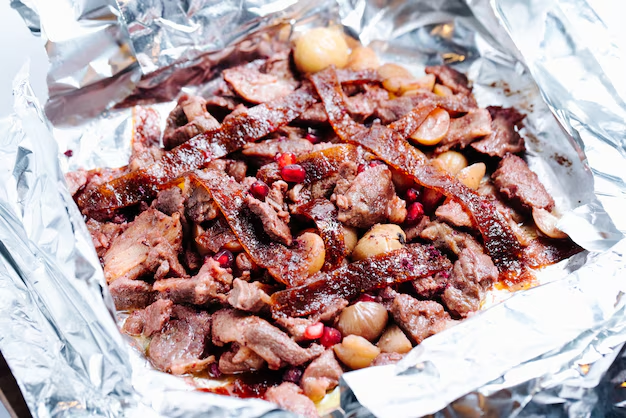Understanding the Shelf Life of Vacuum-Packed Meat in Your Refrigerator
In today's fast-paced world, ensuring that our food stays fresh for as long as possible is crucial for both reducing waste and keeping our meals tasty. Vacuum packing has surged in popularity as a method to extend the lifespan of perishables, especially meat. It locks in freshness by removing air, thereby slowing down the process that leads to spoilage. But just how long can that vacuum-packed steak or chicken breast safely sit in your refrigerator? Let’s dive deep to explore how vacuum packing affects meat storage and maximize your fridge’s potential.
🥩 What is Vacuum-Packing, and Why is It Important?
Vacuum packing involves sealing food items in airtight packaging, usually made of plastic. The vacuum-sealed environment significantly reduces the oxygen levels around the product. Here's why it's beneficial:
- Reduces Oxidation: Lack of air means less oxidation, preventing the growth of aerobic bacteria and mold.
- Preserves Flavor and Nutrients: Keeps your meat's taste and nutritional value intact.
- Prevents Freezer Burn: Perfect for those meats you want to store in the freezer for later.
Despite these advantages, vacuum-packed foods still must be stored properly to ensure longevity and safety.
📅 How Long Can Vacuum-Packed Meat Last in the Refrigerator?
The shelf life of vacuum-packed meat in a refrigerator isn't fixed and varies based on several factors:
1. Type of Meat
Different meats have varying storage capabilities:
- Red Meats (Beef, Lamb): Generally, vacuum-packed red meats can last between 10 to 14 days.
- Poultry: Chicken and turkey typically remain good for about 7 to 10 days.
- Pork: This meat can last around the same duration as beef, possibly extending to about 12 days.
- Processed Meats (Bacon, Sausages): Often last longer, up to two weeks, due to preservatives.
2. Initial Quality of the Meat
The freshness of the meat before vacuum packing also influences its storage life. The fresher the meat at the point of vacuum sealing, the longer it will maintain its quality.
3. Refrigerator Temperature
A constant temperature setting of 34°F to 40°F is ideal for storing vacuum-packed meat. Fluctuating temperatures can compromise the integrity of vacuum-sealed packages due to condensation, promoting bacterial growth.
🛠️ Vacuum Sealing: DIY vs. Store Bought
Investing in a vacuum sealer can be a game-changer for home cooks. However, it’s important to weigh the pros and cons:
DIY Vacuum Sealing
- Pros: Tailored to your specific needs; cost-effective in the long run; reduces packaging waste.
- Cons: Initial investment required; requires proper usage to ensure efficacy.
Store-Bought Vacuum-Packed Meats
- Pros: Professionally sealed ensures reliability; often includes a "best-before" date.
- Cons: Higher cost; less control over packaging size and material used.
🧊 Transitioning from Fridge to Freezer
Storing vacuum-packed meat in a freezer is another excellent option for extending its shelf life further. Here’s a quick comparison of fridge vs. freezer storage for vacuum-packed meats:
| Storage Method | Estimated Shelf Life |
|---|---|
| Refrigerator | Up to 14 days |
| Freezer | 6 months to 2 years |
Key Freezing Tips:
- Freeze as soon as possible after vacuum sealing to preserve quality.
- Label packages with the date of vacuum sealing and expected expiration.
- Ensure consistent freezer temperatures of 0°F or lower.
🚦 Signs that Your Vacuum-Packed Meat Has Gone Bad
Even with the best practices in place, sometimes meat can spoil. Look out for these common indicators:
- Off Odor: A strong sour or ammonia-like smell.
- Discoloration: Gray or brown spots that weren’t present at purchase.
- Slime: A slippery or sticky surface.
When in doubt, it’s always safer to err on the side of caution and discard questionable meat.
⚠️ Practical Tips for Safe Meat Storage
For optimal safety and enjoyment, consider the following:
- Keep Packages Intact: Avoid opening and resealing to prolong freshness.
- Organize Your Fridge: Place vacuum-packed meats on lower shelves to avoid cross-contamination with other foods.
- Monitor Temperatures: Regularly check fridge settings to prevent spoilage.
By following these guidelines, you ensure that your vacuum-packed meat remains safe and delicious, significantly cutting down food wastage and stretching your grocery dollar.
📝 Snapshot: Key Takeaways for Vacuum-Packed Meat Storage
Here’s a quick-reference guide for your kitchen:
- 🕒 Shelf Life: 7–14 days in the fridge; up to 2 years in the freezer.
- 🌡️ Ideal Temperatures: Fridge at 34°F to 40°F; freezer at 0°F.
- 👃 Spoilage Indicators: Off smells, discoloration, and slime.
- 🔍 Quick Tips:
- Seal meat shortly after purchase.
- Label and date all vacuum-packed items.
- Store on lower shelves in the fridge to reduce contamination risk.
Understanding how to effectively store vacuum-packed meats boosts not only shelf life but also your culinary experiences. Knowing the nuances of vacuum sealing empowers you to make informed decisions about how to handle your meat products safely and efficiently. Whether you’re pro dusty DIY or looking for store-bought solutions, these insights will keep your meals delicious and your fridge well-organized. Enjoy the fresh taste of expertly stored meats, knowing exactly how long they will stay good in your refrigerator.
